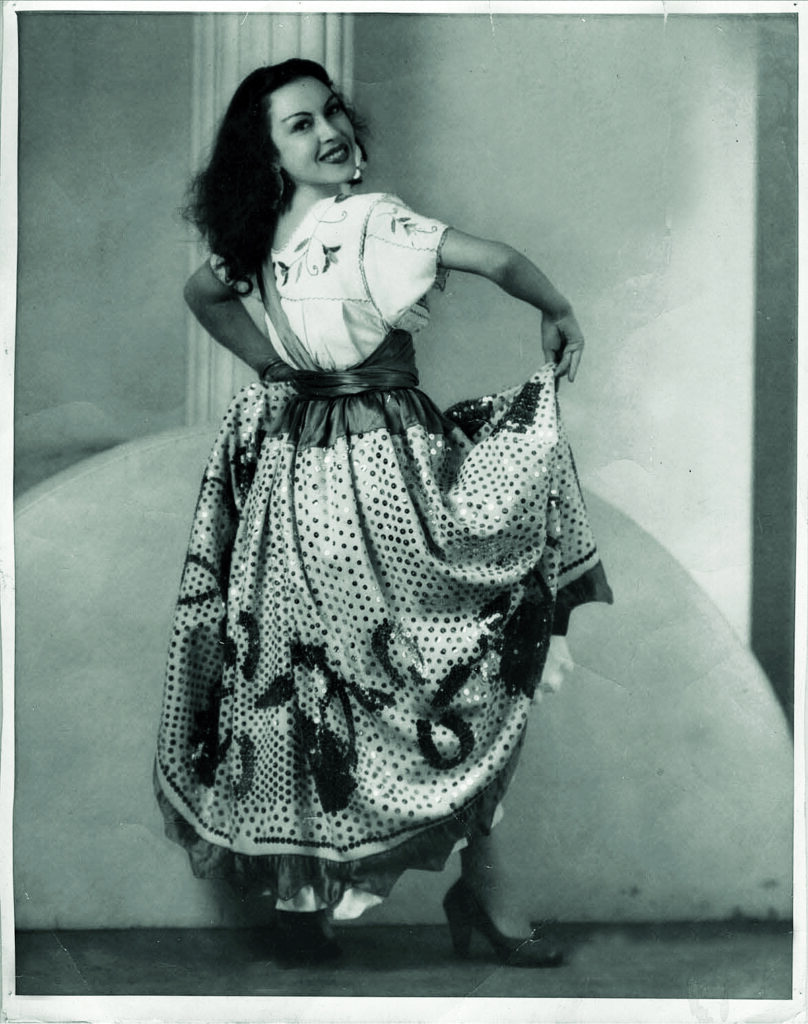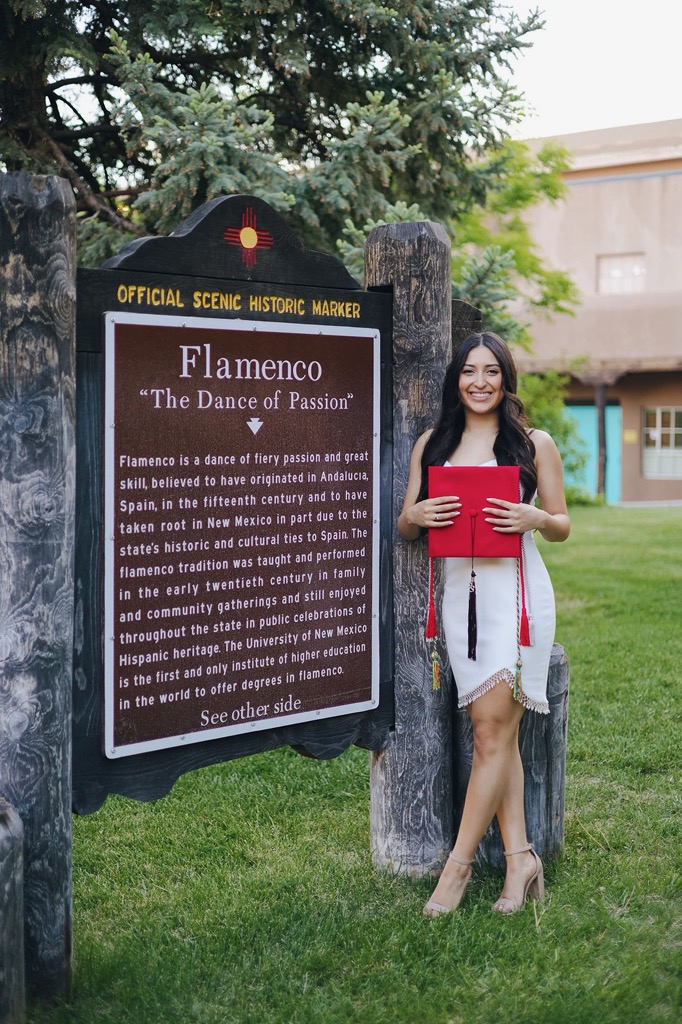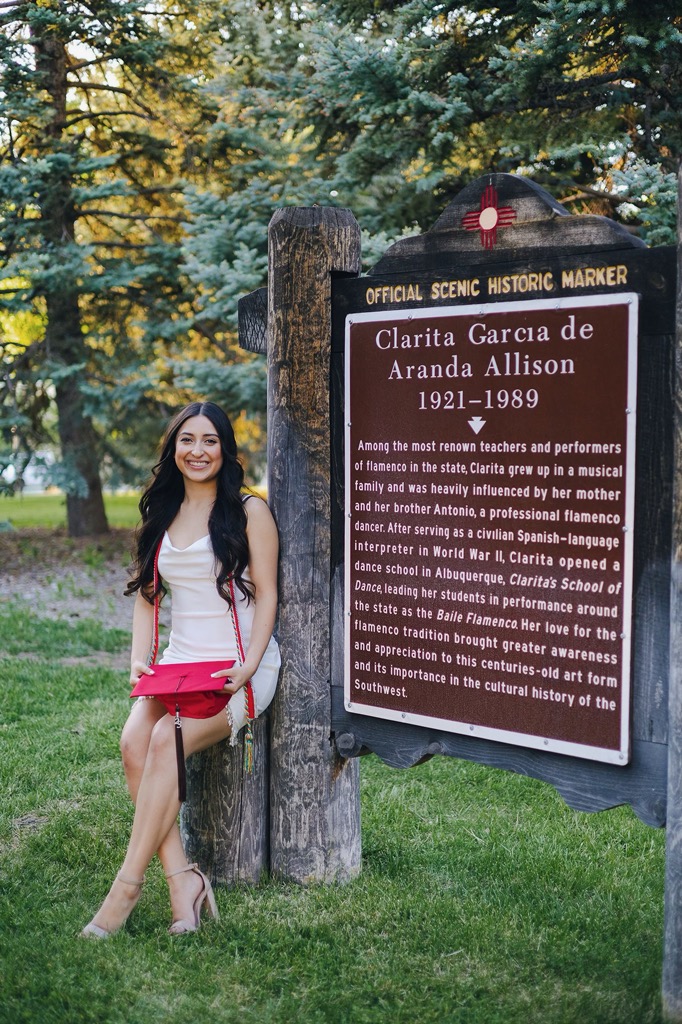Clarita Garcia de Aranda Allison.
Clarita Garcia de Aranda Allison
1921 - 1989
Bernalillo County
Artist
|
Part of a large musical family, her love for the flamenco tradition brought greater awareness and appreciation to this centuries-old art form and its importance in the cultural history of the Southwest.
Born on January 11, 1921 to Juanita Candelaria and Nevarez Garcia de Aranda in Albuquerque, Clarita Garcia de Aranda grew up in a large musical family, with five sisters and three brothers. In a 1988 interview, she said she learned to dance “when I knew my left foot from my right,” taught and influenced by her mother, Juana Garcia Candelaria, who came to the United States when she was young. Clarita learned more than dancing from her mother, adding in the interview that “…Mexican men didn’t think women should be dancers. They thought they should stay at home. But my mother was strong willed. She continued to dance and made sure her children danced in her troupe.” Clarita’s daughter, Eva Enciñias, remembers her grandmother Juanita as a rezadora who sang at funerals and velorios in Albuquerque in the early 1900s.
As Clarita grew, she and her brothers and extended family continued to mature into the art form. She learned to sing and dance professionally during the 1930s and 1940s from three family members who all performed professionally: her old cousin Dandido Garcia, her brother Antonio Garcia (known as “El Garrica”), and her younger cousin Saturnino Garcia.
In 1941, Clarita served as Queen of the Santa Fe Fiesta. Family history and recollection of statements made by Clarita indicate that she moved to Washington, D.C., during World War II to serve as a civilian Spanish-language interpreter. The family believes she may have worked with the WAVES, an acronym for “Women Accepted for Volunteer Emergency Service,” part of the United States Naval Reserve (Women’s Reserve).
In Washington, she met and married Donald K. Allison, an engineer who worked with the U.S. Army. The couple lived in Washington, D.C., for a time, but after the war, Clarita began to perform flamenco professionally, touring the country. Her engagements took her to Sedona, Arizona; the Marymount Theater in New York; and to the World’s Fair in Seattle, Washington, in 1962. She returned to Albuquerque many times as well. In one newspaper article highlighting her upcoming performance at Sandia Base Officer’s Club, she described flamenco music to a reporter, providing insight into her interpretation of the dance. Clarita explained that the art of Flamenco is of ancient and exotic origin, a type of “folk music” with fire, daring, ecstasy, and frenzy, coupled with improvisation. Interpretation depends solely on the dancer and guitarist.
During this time, around 1960, Clarita opened her own school of dance in Albuquerque, originally located at the corner of Edith and Candelaria. Known as “Clarita’s School of Dance,” it specialized in flamenco, with enrollments of up to 40 students at a time. The students, who became known as Baile Flamenco, performed at venues all over the city, including senior centers, nursing homes, schools, YWCAs, Arts in the Parks, church celebrations, Rowlands annual fiestas, San Felipe de Neri Old Town fiestas, and other public events.
Subsequent generations of Clarita’s family have carried on the tradition of performing and teaching flamenco. Her daughter Eva is a professor of dance at the Department of Theater and Dance within the College of Fine Arts at the University of New Mexico in Albuquerque, where she created the first (and at present, only) Bachelor’s and Master’s degree programs with emphasis in flamenco in the country. She also created the Festivál Flamenco de Albuquerque, an annual celebration of flamenco dance that continues today, as well as the National Institute of Flamenco in Albuquerque, which has as its mission, “to preserve and promote flamenco’s artistry, history, and culture by presenting the finest flamenco in the world and by educating the American family in this art form while emphasizing the positive influence of art on family and community.”
Clarita herself continued performing until late in her life. “It’s so nice to be able to sing,” Clarita told reporter David Steinberg in 1988. “It makes you happy when there are so many sad things in the world.” Clarita passed away the following year, on February 25, 1989.
About Flamenco
As an expression of both art and culture, flamenco dance is known for its strong rhythms, colorful clothing, and passionate delivery. In The Spirit of Flamenco: From Spain to New Mexico, Nicolasa Chávez summarizes possible origins of flamenco in Spain in the fifteenth century:
“In the historical discourse on flamenco there is considerable debate regarding the amount of mixing that took place between regional dance and music, the various cultures of Spain, and traditions perceived as of pure Gitano (Gypsy) origin.”
Generally, history holds that flamenco was developed in the mountain caves of Andalusia by Gitanos shortly after they were expelled by the Catholic monarchs Ferdinand and Isabella at the end of the fifteenth century. The recently married rulers united the kingdoms of Castile and Aragon and issued an edict in 1492 in an effort to cleanse the newly formed Spanish empire of minority groups. Jews, Muslims, and Gitanos were told to convert to Christianity or face expulsion from the country. Some of these people did leave Spain; others hid in caves. The first examples of what is known as flamenco’s deep song, or cante jondo, stem from these expelled peoples. Their early songs, often referred to as “cries” or “laments,” tell stories of pain, loss, suffering, displacement, death, and heartache. They are more somber than the regional musical traditions and are considered to be the oldest, purest, and most profound of flamenco songs.”
Jacqueline Garcia of the National Institute of Flamenco describes flamenco as “a complex art form originally created, crafted, and refined by Gitanos, Spanish gypsies… Our own expression of flamenco in New Mexico is deeply rooted in the traditional Gitano experience, and yet continues to grow through the creation of a new flamenco culture.”
With the arrival of Spanish colonists and conquistadors into New Mexico, folk songs and dances remained part of the tradition and culture. Many of the Hispano families that migrated from Spain or grew up while Spanish Conquistadors moved through Mexico and New Mexico maintained cultural and folkloric traditions. Many of these forms evolved and morphed over time but remained in families and communities and began to take formal recognition in the early 1900s within the context of the Santa Fe Fiesta.
A “Spanish craze” in the early 1900s brought interest in Spanish music and architecture and may have been an underpinning of the rise of flamenco in the country. Santa Fe Fiesta and other celebrations of Hispanic culture and heritage throughout the state provided venues for the introduction of flamenco, which helped lead to its acceptance as part of New Mexico’s traditions and heritage. While flamenco was not officially part of the first fiesta in 1919, Spanish dancers draped in silk shawls and playing castanets performed at the Plaza, which led to the incorporation of flamenco into performances throughout the city. Fiestas throughout the state since the 1960s have also included flamenco. The closing ceremony of the 400th anniversary of Santa Fe’s founding included flamenco to represent New Mexico’s Spanish heritage and mariachi to represent the state’s Mexican heritage.
Serving as Fiesta Queen in 1941 was Clarita Garcia de Aranda Allison, to whom is due much credit for both preserving and elevating the art form of flamenco in New Mexico. During her competition for the Fiesta, Clarita performed flamenco.
Sources:
Personal communications with Eva Enciñias, professor of dance at the University of New Mexico, September-November, 2016. Enciñias is Clarita’s daughter.
“Flamenco Artists Will Perform Before Sandia Base Woman’s Club.” Albuquerque Journal, Sunday, November 18, 1962.
Chávez, Nicolasa. The Spirit of Flamenco: From Spain to New Mexico. Santa Fe: Museum of New Mexico Press, 2015.
Department of Theater and Dance, College of Fine Arts, UNM, http://theatre.unm.edu/people/faculty.php, accessed November 2, 2016.
Garcia, Jacqueline. “The History of Flamenco in Albuquerque.” http://www.visitalbuquerque.org/abq365/blog/post/2015/14/The-History-of-Flamenco-in- Albuquerque/176/, accessed November 2, 2016.
National Institute of Flamenco, http://www.nifnm.org/, accessed November 2, 2016.
Santa Fe Fiesta Council, http://www.santafefiesta.org/about-us/, accessed November 2, 2016.
Steinberg, David. “Flamenco: A Lifetime of Rhythm.” Albuquerque Journal, Sunday, September 25, 1988.









